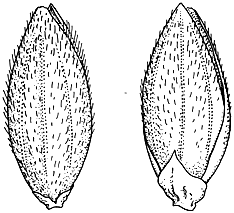Urochloa advena (Vickery) R.D.Webster APNI* Synonyms: Brachiaria advena Vickery APNI*

Description: Decumbent perennial with culms to 1.2 m long, rooting from nodes.
Leaves with blade to 5 mm wide, glabrous.
Inflorescence exserted at maturity, 1-sided. Racemes 6–14, erect, to 2.5 cm long, pubescent, bearing the subsessile spikelets in 2 close ranks on 1 side of the axis. Spikelets 3–3.5 mm long, pubescent. Lower glume 25% the length of the spikelet or sometimes shorter, glabrous; upper glume equalling the spikelet, 5-nerved. Lower lemma similar to the upper glume in size, shape and texture, 5-nerved for 70–90%, 3-nerved for 100% of its length, its margins hyaline, without a palea. Fertile floret indurate, c. 2.5 mm long, minutely papillose-rugose in faint parallel longitudinal lines. Palea similarly indurate and papillose-rugose and, together with the lemma, enclosing the grain, its margins hyaline. and papillose-rugose and, together with the lemma, enclosing the grain, its margins hyaline.
Flowering: summer.
Distribution and occurrence: Weed of cultivation and pastures. Native of S Afr.
NSW subdivisions: *NT, *NWS
Text by S. W. L. Jacobs & C. A. Wall
Taxon concept: Flora of NSW 4 (1993) and Grasses of New South Wales, Fourth Edition (2008).
APNI* Provides a link to the Australian Plant Name Index (hosted by the Australian National Botanic Gardens) for comprehensive bibliographic data
***The AVH map option provides a detailed interactive Australia wide distribution map drawn from collections held by all major Australian herbaria participating in the Australian Virtual Herbarium project.
|


